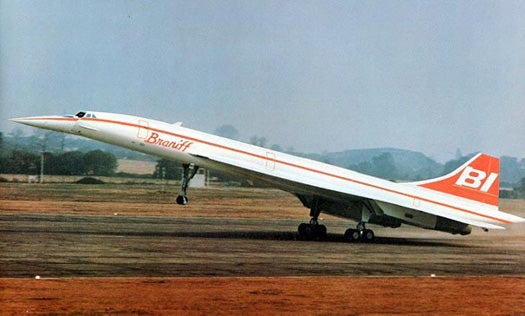Future Then Video: Braniff Goes Supersonic
What the "future" of supersonic air travel looked like in 1975

Here at PopSci, we spend our fair share of time marveling at fantastic visions of the future. So as a result, we know better than anyone how fun it can be looking back a few decades at the visions that flew a bit too close to the sun. And that’s what this new series, The Future Then Video (inspired by our magazine’s back page), is all about–taking a look back at retro visions of the future and seeing how their predictions panned out.
In our first episode, we’re looking at an amazing promotional film that Braniff International made in 1975 to get customers excited about supersonic air travel.
Braniff began operating Concorde flight between Dallas, TX and Washington, DC in 1979. These technically weren’t supersonic flights, though — because of noise pollution from sonic booms, Congress had outlawed supersonic service over the domestic U.S. So when the Concorde touched down in DC, the Braniff pilots would swap out for a British Airways crew, who would take care of the fun stuff at Mach 2 over the Atlantic.
But as you can see, that didn’t stop Braniff from portraying supersonic air travel as an amazingly futuristic feat right out of science fiction — complete with silver helmets for passengers, “mood controls” in every seat, and jetpack-equipped flight crews.
Braniff wasn’t totally off the mark, though. Here are the things their cheesy film actually got right (or, at least in the ballpark) about the future of air travel:
- Smart ID. All US passports have had RFID chips in them since 2007. And more recently, plans have surfaced to potentially upgrade e-passports to include flexible wirelessly-powered screens that show a 360-degree rotating view of your head instead of a boring little photo.
- High-speed direct rail connections. We take them for granted now, but fast, convenient airport rail lines didn’t become commonplace until the 1980s. And superfast maglev trains — like Shanghai’s Transrapid system, which debuted in 2003 with a top speed of 311 mph — are still only found in Europe and Asia, not the United States. (Although not for lack of trying.)
- Robots. Again, Asia has us trumped: RoboPorters (yup, that’s really what they’re called) were deployed in Japan’s Kita Kyushu airport in 2008, each capable of schlepping up to 100 pounds of luggage. Then again, we have robot pilots. Beat that!
- On-demand entertainment. In Braniff’s film, passengers are delighted to have a whopping three movies to choose from. These days, we’d consider such limited choices as grounds for a refund. And before long, in-flight broadband internet service will make even VOD seem quaint.
Overall, not half bad for a 34-year-old film. Aside from the gratuitous helmets, of course.